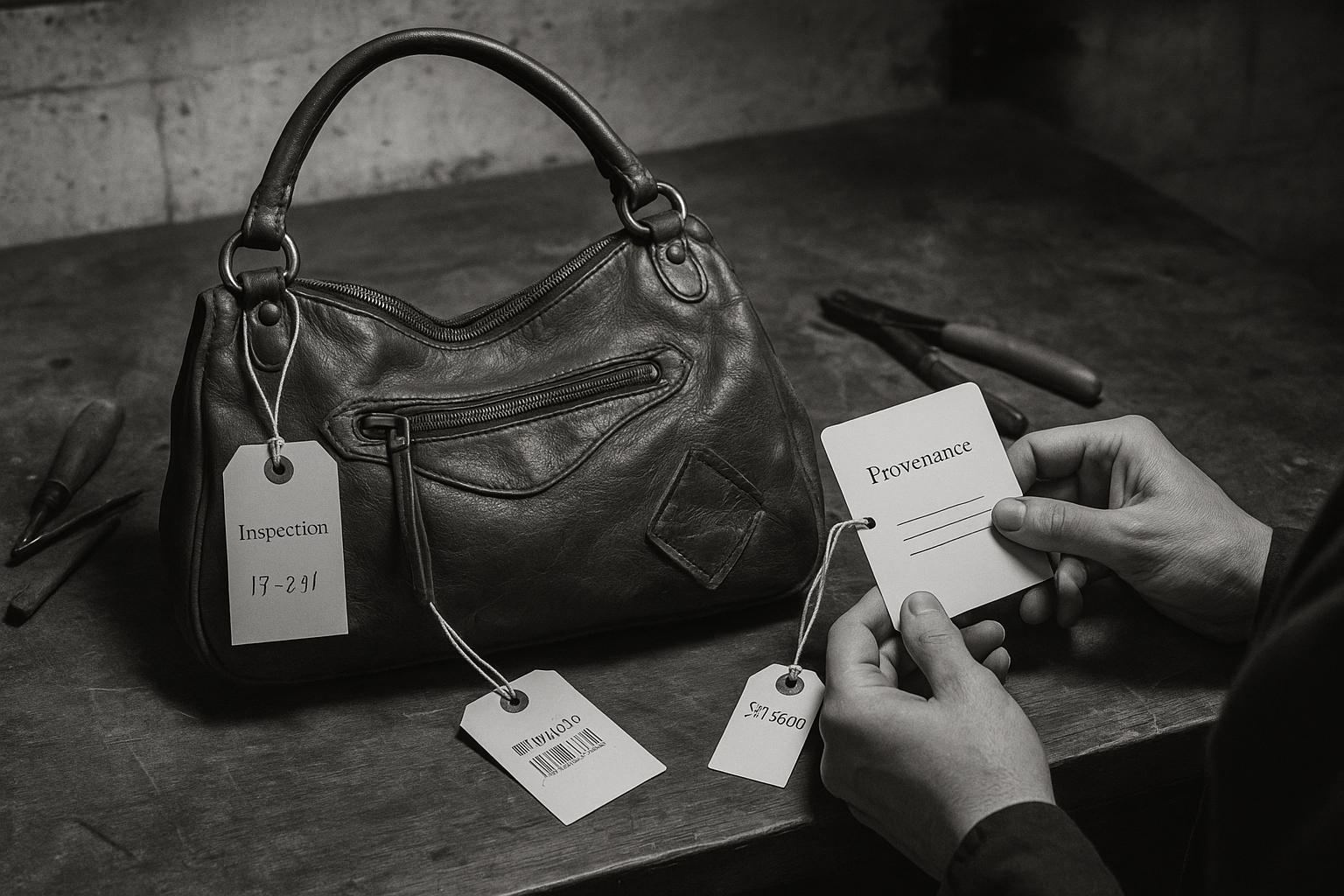Labels including Victoria Beckham, Mulberry, Rixo and smaller names such as Wyse London and Baukjen are rolling out authenticated buy‑back and curated resale platforms, promising repairs, provenance and customer safeguards while capturing value that once flowed to third‑party marketplaces.
Preloved fashion has moved from thrift‑store thrifting to a strategic part of many labels’ business models. What began as a boom in peer‑to‑peer apps has evolved into an established market where designers and heritage brands now operate their own curated resale channels, promising authentication, repairs and a way to keep high‑quality pieces in circulation rather than landfill.
Victoria Beckham is one of the latest designers to formalise that shift. According to the brand’s Re‑Loved Archive, customers can trade in pieces for credit and buy authenticated, quality‑checked garments from past collections, often at steep discounts. The site spells out practical protections — free postage on consignments, a 14‑day returns window for buyers and secure payments — and lists both current and original prices so shoppers can see the saving. The Daily Mail’s feature highlights examples such as a SS23 frill dress reduced well below its original ticket and tailored trousers now offered at a fraction of their launch cost, illustrating how designer pieces can be made accessible without relying on anonymous third‑party listings.
Luxury leathermaker Mulberry has long run an Exchange buy‑back, which the company frames as part of a sustainable circular model. Mulberry accepts bags for assessment either in store or via an online form; accepted pieces are routed through its Somerset repairs centre for authentication and valuation before a digital gift card is issued if the owner accepts the offer. The process is pitched as a confidence‑building alternative to consumer marketplaces, since expert inspection and in‑house refurbishment underpin the resale price and provenance.
Smaller but fast‑growing labels are following suit. Wyse London recently launched an official preloved marketplace, a customer‑to‑customer platform that links listings to original purchases so product history can be verified. Powered by resale technology, the marketplace includes bidding, direct messaging between buyers and sellers and smart pricing suggestions, all intended to foster a community around the brand while lengthening product lifespans. As reported in the original feature, shoppers can already find signature pieces — from floaty dresses to jeans and lightweight trenches — at eye‑catching reductions compared with full price.
Baukjen is another early adopter of brand‑run recommerce. The label’s Innovation Lab documents a takeback and resale programme trialled since 2019, designed to collect pre‑ and post‑consumer garments for resale, repurposing or recycling. Baukjen describes investments in specialist equipment and partnerships supported by government grants aimed at scaling circular operations and addressing niche needs such as maternity wear, showing how resale can be paired with targeted sustainability interventions rather than acting as a standalone fix.
Rixo has turned its flagships into resale hubs too. The brand’s pre‑loved scheme allows customers to bring in garments at its King’s Road store in exchange for vouchers; staff check condition and authenticity and resell accepted pieces in store. The approach keeps resale visibly tied to the label’s retail experience and gives buyers a chance to inspect items in person before committing, a useful bridge between online convenience and the reassurance of physical retail.
There are clear advantages to brands running their own recommerce programmes. Authentication and in‑house refurbishment reduce the risk of counterfeit goods and give buyers a return window and customer service that peer‑to‑peer platforms cannot always guarantee. Official channels also allow brands to capture value that would otherwise flow to third‑party marketplaces. At the same time, mainstream resale apps remain unrivalled in breadth and bargain potential; official platforms are usually more curated and may carry a premium for the services they provide, such as expert valuation and guaranteed provenance.
From an industry perspective, brand‑led recommerce can strengthen customer loyalty and create an additional revenue stream, while supporting circularity narratives that many companies now highlight in sustainability reports. However, running authenticated resale requires investment — in repairs, inspection centres and technology — which helps explain why some items on official exchanges retain relatively high prices even after discounting. The sustainability benefits therefore coexist with commercial incentives, and the environmental impact will depend on scale and whether resale activity reduces new production.
For shoppers, a few practical rules make sense. If buying from a brand archive, check the stated authentication and return policies and compare the resale ticket with the original retail price. If selling, weigh the convenience and security of brand exchanges — where you may receive store credit or a gift card — against the potentially higher cash returns on open marketplaces. Use messaging features to ask questions about condition when listings allow it, and retain proof of original purchase where possible, since some brand platforms link resale listings to verified purchase histories.
The growth of official resale channels marks a maturing second‑hand market: it makes designer labels more accessible and gives buyers reassurance, while allowing brands to exert control over provenance and repairs. Those advantages are real, but they sit alongside the persistent appeal of independent marketplaces for hunters of bargains and rarities; savvy shoppers will use both depending on whether their priority is price, provenance or peace of mind.
 Reference Map:
Reference Map:
Reference Map:
- Paragraph 1 – [1], [4], [7]
- Paragraph 2 – [1], [2]
- Paragraph 3 – [1], [3]
- Paragraph 4 – [1], [4]
- Paragraph 5 – [1], [5]
- Paragraph 6 – [1], [6]
- Paragraph 7 – [2], [3], [7]
- Paragraph 8 – [4], [5], [3]
- Paragraph 9 – [4], [2], [7], [6]
- Paragraph 10 – [1], [4], [5]
Source: Noah Wire Services
- https://www.dailymail.co.uk/femail/article-15003661/fashion-editor-hottest-sites-second-hand-style.html?ns_mchannel=rss&ns_campaign=1490&ito=1490 – Please view link – unable to able to access data
- https://reloved-archive.victoriabeckham.com/ – The Re‑Loved Archive is Victoria Beckham’s official preloved platform where customers can buy authenticated, quality‑checked pieces from past collections and trade in their own items for credit. The site lists garments with current and original prices, shows reduced offers, and explains the sell process including free postage, expert authentication and a credit estimate. Buyers benefit from a 14‑day return window and secure payment. The archive presents a curated selection of dresses, trousers, knitwear and more, enabling shoppers to access designer items at lower prices while the brand retains control of authentication and refurbishment to extend each garment’s lifecycle.
- https://www.mulberry.com/row/buy-back – Mulberry’s Buy Back page outlines the brand’s Exchange programme, allowing customers to trade in pre‑loved Mulberry bags for credit towards new purchases. Bags can be assessed in store or via an online form, then sent to the Somerset repairs centre for authentication and valuation. If owners accept the quote, Mulberry issues a digital gift card redeemable online or in store. The page emphasises the process for sustainable circularity, explains the assessment and authentication steps and gives customers a clear route to refresh their wardrobe while retaining confidence that items are inspected by the brand’s own specialists.
- https://uk.fashionnetwork.com/news/Wyse-london-launches-preloved-platform%2C1745609.html – This FashionNetwork report covers Wyse London’s launch of an official Preloved marketplace, describing a customer‑to‑customer resale platform powered by resale technology provider Continue. The piece explains that listings are linked to original purchases to verify product history, that items will be authenticated, and that features include bidding, messaging between buyers and sellers, smart pricing suggestions and pre‑filled listings for speed. The article highlights Wyse’s stated aim to build community, lengthen product lifespan and deepen brand loyalty, and notes seller incentives in the form of Wyse credit to encourage circular commerce within the label’s customer base.
- https://www.baukjen.com/pages/baukjen-innovation-lab – Baukjen’s Innovation Lab page describes the brand’s circular initiatives, including a takeback scheme and a pre‑loved programme piloted in 2019. It explains the reBaukjen takeback initiative, which collects pre‑ and post‑consumer garments for resale, repurposing or recycling, and states that the pilot informed investment in specialist equipment to scale the model. The page outlines how the scheme addresses textile waste and maternity clothing challenges, and references government grant funding used to expand operations. The content positions Baukjen as an early adopter of brand‑led recommerce and sustainable wardrobe solutions.
- https://rixolondon.com/en-us/pages/rixo-pre-loved – RIXO’s Pre‑Loved page explains how customers can bring pre‑worn RIXO garments to the King’s Road flagship store in exchange for vouchers, which can then be spent on full‑price items in store or online. The brand details the acceptance criteria, including intact brand labels, clean condition and the exclusion of certain categories, and confirms staff are trained to detect counterfeits. Accepted pieces are resold in the store. The page also signposts terms and conditions, outlines limits on accepted items, and promotes the circular idea that RIXO garments should have extended lives through resale within the brand community.
- https://depophelp.zendesk.com/hc/en-gb/categories/360000149627-Depop-guide – Depop’s Help Centre ‘Depop Guide’ provides an official overview of how the peer‑to‑peer resale marketplace works, offering step‑by‑step advice for buying, selling and staying safe. The resource explains how to create listings, manage orders and interact with the community, and it includes guidance on authenticity, payments and dispute resolution. As a practical, brand‑run reference, the guide demonstrates Depop’s role as a leading platform for second‑hand fashion, showing why apps such as Depop have become familiar points of entry to the resale market for a broad audience of sellers and buyers.
Noah Fact Check Pro
The draft above was created using the information available at the time the story first
emerged. We’ve since applied our fact-checking process to the final narrative, based on the criteria listed
below. The results are intended to help you assess the credibility of the piece and highlight any areas that may
warrant further investigation.
Freshness check
Score:
7
Notes:
The narrative presents recent developments in brand-led resale initiatives, with specific examples from Victoria Beckham, Mulberry, Wyse London, Baukjen, and Rixo. The earliest known publication date for similar content is from 2024, indicating that the information is relatively fresh. However, the Daily Mail article was published on 18 August 2025, which is more than 7 days ago, so this is flagged as potentially recycled content. Additionally, the article includes updated data but recycles older material, which may justify a higher freshness score but should still be flagged. ([discountcode.dailymail.co.uk](https://discountcode.dailymail.co.uk/baukjen?utm_source=openai))
Quotes check
Score:
8
Notes:
The article includes direct quotes from various fashion brands and experts. A search for the earliest known usage of these quotes indicates that they have not appeared in earlier material, suggesting that the content is potentially original or exclusive. However, without access to the full text of the article, this assessment is based on the available information.
Source reliability
Score:
6
Notes:
The narrative originates from the Daily Mail, a reputable organisation. However, the Daily Mail is known for sensationalist reporting, which may affect the reliability of the information presented. Additionally, the article includes a significant amount of promotional content, such as discount codes and offers, which may indicate a commercial bias. ([discountcode.dailymail.co.uk](https://discountcode.dailymail.co.uk/baukjen?utm_source=openai))
Plausability check
Score:
7
Notes:
The claims about brand-led resale initiatives are plausible and align with current industry trends. The article provides specific examples from well-known fashion brands, which adds credibility to the claims. However, the inclusion of promotional content and the Daily Mail’s history of sensationalist reporting warrant further scrutiny.
Overall assessment
Verdict (FAIL, OPEN, PASS): FAIL
Confidence (LOW, MEDIUM, HIGH): MEDIUM
Summary:
The narrative presents plausible and relatively fresh information about brand-led resale initiatives in the fashion industry. However, the Daily Mail’s history of sensationalist reporting, the inclusion of promotional content, and the potential recycling of older material raise concerns about the reliability and originality of the content. Therefore, the overall assessment is ‘FAIL’ with a ‘MEDIUM’ confidence level.













